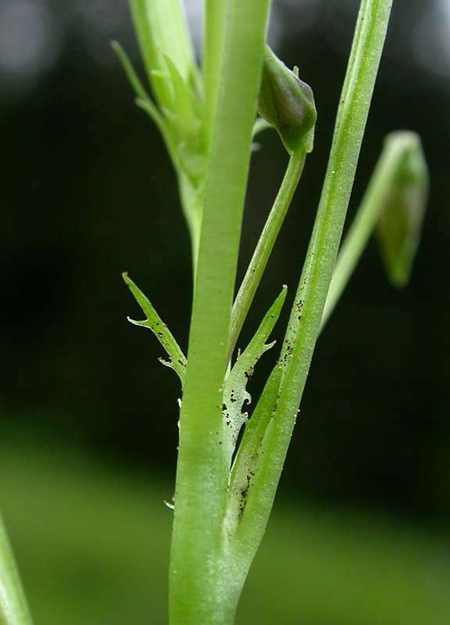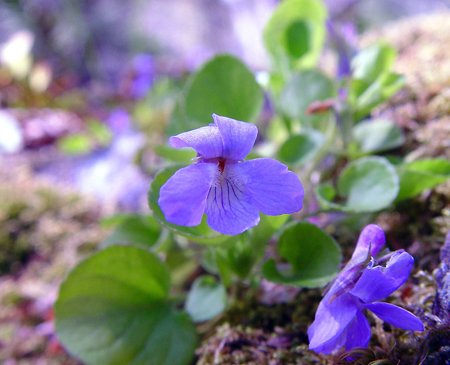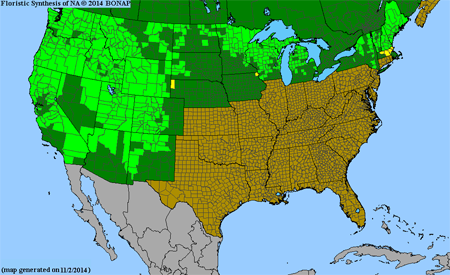Viola adunca Sm.
Common names:
Hook-spurred Violet
Synonyms:
Viola adunca Sm., in Rees, Cycl. 37: no. 63. 1817-1818; Lophion aduncum (Sm.) Nieuwl. & Lunell, Amer. Midl. Naturalist 4: 478. 1916.; Viola canina Walter var. adunca (Sm.) A.Gray, Bot. Gaz. 11(11): 292. 1886. TYPE: West coast of N. A., 1803, Menzies s.n. (TYPE: LINN-image!; duplicates: BM, UC-photo!).
Viola aduncoides A.Löve & D.Löve, Bot. Not. 128(4): 516. 1976 ['1975']
Viola adunca Sm. var. kirkii V.G.Duran, Leafl. W. Bot. 10: 319. 1966
Viola adunca Sm. var. uncinulata (Greene) C.L.Hitchc., Vasc. Pl. Pacific NorthW. 3: 440. 1961; Viola adunca Sm. var. uncinulata (Greene) Applegate, Amer. Midl. Naturalist 22: 282. 1939; Viola uncinulata Greene, Leafl. bot. observ. 2(2): 97. 1910-1912
Viola adunca Sm. var. cascadensis (M.S.Baker) C.L.Hitchcock, Vasc. Pl. Pacific NorthW. 3: 440. 1961; Viola cascadensis M.S.Baker, Leafl. W. Bot. 5: 173. 1949
Viola adunca Sm. var. bellidifolia (Greene) H.D.Harr., Man. Pl. Colorado: 377, 641. 1954; Viola bellidifolia Greene, Pittonia 4: 292. 1901
Viola adunca Sm. f. candida Lepage, Naturaliste Canad. 79: 180. 1942
Viola adunca Sm. f. albiflora Vict. & J.Rousseau, Contr. Inst. Bot. Univ. Montreal 36: 20. 1940
Viola bellidifolia Greene subsp. typica M.S.Baker, Madroño 5: 223. 1940
Viola bellidifolia Greene subsp. valida M.S.Baker, Madroño 5: 223, pl. 21, 22, fig. 8. 1940
Viola adunca Sm. f. glabra (Brainerd) G.N.Jones, Univ. Wash. Publ. Biol. 5: 194. 1936; Lophion aduncum Nieuwl. & Lunell var. glabrum (Brainerd) Nieuwl. & Lunell, Amer. Midl. Naturalist 4: 478. 1916; Viola adunca Sm. var. glabra Brainerd, Rhodora 15: 109. 1913
Viola adunca Sm. subsp. ashtonae M.S.Baker, Madroño 3: 233, pl. 11, figs. 4, 7. 1936
Viola adunca Sm. subsp. radicosa M.S.Baker, Madroño 3: 234, pl. 11, fig. 5. 1936
Viola adunca Sm. subsp. typica M.S.Baker, Madroño 3: 233. 1936
Viola verbascula Greene, Leafl. bot. observ. 2(2): 32. 1910-1912
Viola centellifolia Greene, Leafl. bot. observ. 2(2): 98. 1910-1912
Viola oxysepala Greene, Leafl. bot. observ. 2(2): 34. 1910-1912
Viola anisopetala Greene, Leafl. bot. observ. 2(2): 97. 1910-1912; Lophion anisopetalum (Greene) Nieuwl. & Lunell, Amer. Midl. Naturalist 4: 478. 1916
Viola cordulata Greene, Leafl. bot. observ. 2(2): 33. 1910-1912
Viola huronensis Greene, Leafl. bot. observ. 2(2): 96. 1910-1912
Viola adunca Sm. subsp. oxyceras (S.Watson) Piper, Contr. U.S. Natl. Herb. 11: 395. 1906; Viola oxyceras (S.Watson) Greene, Pittonia 3: 255. 1897; Viola adunca Sm. var. oxyceras (S.Watson) S.Watson ex Jeps. [no bibliographic data available]; Viola canina Walter var. oxyceras S.Watson, in W.H.Brewer & S.Watson, Bot. California 1: 56. 1876.
Viola unguiculata Greene, Pittonia 4: 291. 1901
Viola fulcrata Greene, Pittonia 4: 285. 1901
Viola cardaminifolia Greene, Pittonia 4: 289. 1901
Viola oreocallis Greene, Pittonia 4: 288. 1901
Viola albertina Greene, Pittonia 4: 288. 1901
Viola demissa Greene, Pl. baker. 3: 10. 1901
Viola desertorum Greene, Pittonia 4: 291. 1901
Viola filipes Greene, Pittonia 4: 289. 1901
Viola inamoena Greene, Pl. baker. 3: 11. 1901
Viola petrophila Greene, Pittonia 4: 286. 1901
Viola stenantha Greene, Pl. baker. 3: 10. 1901
Viola adunca Sm. var. longipes (Nutt.) Rydb., Mem. New York Bot. Gard. 1: 263. 1900; Viola longipes Nutt., in Torr. & A.Gray, Fl. N. Amer. 1: 140. 1838
Viola subvestita Greene, Erythea 5: 39. 1897
Viola silvatica Fr. ex Hartm.f. var. adunca (Sm.) Kurz, Bot. Jahrb. Syst. 19: 364. 1894
Viola silvestris var. puberula (S.Watson) E.Sheld., Bull. Geol. Nat. Hist. Surv. 9: 17. 1894; Viola canina Walter var. puberula S.Watson, in S.Watson & J.M.Coult., Manual, ed. 6: 81. 1890
Viola muhlenbergii Torr. var. pubescens A.Gray, Amer. J. Sci. Arts 33: 404. 1862
Viola diversifolia Nutt., Gen. N. Amer. Pl.: 140. 1838
Viola muhlenbergiana Ging. var. albiflora Hook., Fl. bor.-amer. 1: 78. 1830
Description:
Caulescent perennials from somewhat slender rhizome, stems ascending in flower but commonly reclining in fruit, commonly > 2, < 16 cm tall; stems, foliage and peduncles blue-green, puberulent (very rarely glabrous in our region) with hairs up to 0.30 mm long, guard cells 22-30 µm long; leaves cauline and basal, cauline distributed along stem; stipules free, deeply incised; leaves ascending to spreading, leaf blades undivided, largest ≤ 33 × 28 mm, narrowly ovate-triangular to narrowly ovate, base broadly rounded to subcordate, margins subcrenate to subentire and often revolute, ciliolate (rarely eciliate), apex narrowly rounded; chasmogamous flower ≤ 16 mm; calyx glabrous or sepals puberulent along midvein, eciliate; lowest sepals linear-lanceolate to lanceolate, acute; auricles short and entire or prominent and erose, not elongating in fruit; corolla medium to dark blue, throat white; spur elongate, slender, 5–7 mm, blue to white; lateral petals densely bearded with filiform hairs, spurred petal glabrous; style abruptly expanded into head; projections on head (when present) cylindrical, lengths up to 1/6 the width of the head; tip below stigmatic orifice abruptly bent upward at ca. 90 °; pollen grains 3.2-4.6 µ in diameter; cleistogamous flowers produced after chasmogamous; capsule 6–9 mm, green drying tan, unspotted or with fine red spots, glabrous; seeds 1.5–2.0 × 0.9–1.0 mm, medium to dark brown, unspotted; 2n=20.
Similar species:
This caulescent northern species and the mat-forming southern V. walteri share the unusual feature of densely puberulent foliage. It is very similar with the boreal tetraploid V. aduncoides (not yet confirmed in our range) but can be distinguished by the several style features and shorter foliage puberulence as noted in the key. It is immediately distinct from V. labradorica and other non-puberulent caulescent species by its dark blue-green typically puberulent foliage, narrowly ovate leaf blades with subentire to shallowly crenate and often revolute margins, and deeply lacerate stipules.
Ecology:
Dry sandy and rocky ground in forests and parklands, rock crevices or talus.
Distribution:
Transcontinental, GL and QC to AK, south to MA, NY, MI, WI, n. MN, and w. SD, widespread in the Rocky Mountains.
Rarity:
State listed in CT, IA, and MA.
Phenology:
Chasmogamous flower May–June, chasmogamous fruit June–July, cleistogamous fruit July–September.
Affinities:
This species belongs to the Rostrate Violet lineage, sect. Viola, subsect. Rostratae (Kupffer.) W.Becker.
Hybrids:
Hybridizes with V. aduncoides (McPherson and Packer 1974) and V. labradorica (Brainerd 1924, Ballard 1992, Ballard 1995, Haines et al. 2011). According to McPherson and Packer, and Brainerd, both hybrids are sterile, neither reproducing by chasmogamous flowers nor producing viable cleistogamous seeds. I have observed the hybrid with V. labradorica and have found the features of chasmogamous flowers and foliage to be precisely intermediate, although Brainerd reports some variation.
Comments:
This species and V. aduncoides are immediately distinguishable from other rostrate violets by their blue-green foliage color, subentire leaf blades, and (commonly in our region) densely puberulent indument. Brainerd (1921b), Brainerd Baird (1942), Russell (1965), Ballard (1995), Haines et al. (2011), Voss and Reznicek (2012), and Little and McKinney 2015) accepted V. adunca as a distinct, broadly delimited species (implicitly including V. aduncoides) separate from V. labradorica, while Fernald (1950), Alexander (1963), and Scoggan (1978) treated the present species as var. adunca and segregated glabrous plants of V. adunca together with boreal and alpine populations of V. labradorica as V. adunca var. minor (Hook.) Fernald, following Fernald's (1949) initial taxonomic error of treating the two taxa as equivalent (see V. labradorica for clarification on this). Gleason and Cronquist (1991) synonymized both under V. adunca. Viola adunca as a species complex is quite variable across its range, with more than 50 names attributed to that variability. McPherson and Packer (1974) documented fertile diploid (2n=20) and tetraploid (2n=40) cytotypes, and a sterile triploid (2n=30) cytotype assumed to be the hybrid. They observed that the style head of the diploids bore longer, more crowded cylindrical projections, longer hairs on the foliage (when present), shorter guard cells and smaller pollen grains. Photographs of the styles also suggest that the diploid style abruptly expands near the head and the tip containing the stigmatic orifice is abruptly bent upward at ca. 90°, while the tetraploid style remains nearly uniformly cylindrical to the head and the tip containing the stigmatic orifice is angled upward at ca. 45°, although the authors made no comment on this. Diploids comprised all specimens and study populations north and east of Lake Superior, as well as south of the U.S.-Canadian border in w. North America, with only sporadic occurrences northward in the range of the tetraploid. The tetraploid was confined to the region of Canada westnorthwest from the n. shore of Lake Superior. The authors noted that the diploid differed slightly biochemically, flowered two weeks earlier than the tetraploid in the greenhouse, and was further isolated by the absolute sterility of the triploid hybrids. Although the type of V. adunca Sm. was likely collected my Menzies in a region dominated by diploids and could be assumed to be diploid, McPherson and Packer hesitated to provide a name to one of the cytotypes because the status of the type was not yet confirmed with certainty. That did not stop Löve and Löve (1976) from publishing the name Viola aduncoides for the tetraploid, based on a type from Winnipeg, Manitoba. Mauer et al. (1978) later studied the cytotypes physiologically but found no statistical differences in their behavior. Ballard (1992) examined macromorphological traits of flowers and leaves across the range of V. adunca and was unable to separate macromorphological taxa in V. adunca sensu lato based on leaf morphology alone; nevertheless, the two cytotypes are morphologically differentiated in style morphology and indument, and foliage indument, express a phenological shift in chasmogamous flowering suggesting some degree of physiological differentiation, are reproductively isolated by ploidy level, and have largely allopatric distributions. They are recognized here as distinct evolutionary species, applying the name Viola aduncoides for the tetraploid. According to McPherson and Packer's distribution map, our ne. populations are V. adunca, while those in the Thunder Bay region and nw. are mostly V. aduncoides. Typical V. adunca sensu lato, with densely puberulent foliage, is the ubiquitous form in our region. Glabrous plants across the range of V. adunca sensu lato have received various names, including var. glabra Brainerd (type material from Bonaventure, Quebec, which could be assumed to belong to V. adunca sensu stricto). Glabrate to glabrous plants in our region invariably grow intermingled with puberulent ones, in exposed sites such as conglomerate Great Lakes shorelines or windswept bluffs, where immediate environmental conditions could obviously abrade the foliage epidermis or hairs. Indument loss in this case is probably a phenotypic response rather than a genetically fixed trait, and taxonomic recognition of glabrous or glabrate plants in our region seems unwarranted. Conversely, in western North America such plants often proliferate uniform populations separate from puberulent populations, often at higher elevations, and additionally express other foliage and floral differences from typical V. adunca or V. aduncoides. Some of these (e.g., V. bellidifolia Greene) very likely deserve taxonomic recognition at the species level (Ross McCauley, pers. comm.).
Literature Cited:
Alexander, E. J. 1963. Violaceae. In Gleason, H. A., The new Britton and Brown illustrated flora of the northeastern United States and adjacent Canada. Hafner Publishing Co., Inc., New York, NY. 552-567.
Ballard Jr., H. E. 1992. Systematics of Viola section Viola in North America north of Mexico. M.S. thesis. Central Michigan University, Mount Pleasant, MI.
Ballard Jr., H. E. 1995 ["1994"]. Violets of Michigan. Michigan Botanist 33: 131-199.
Brainerd, E. 1921b. Violets of North America. Vermont Agricultural Experiment Station Bulletin 224: 1–172.
Brainerd, E. 1924. The natural violet hybrids of North America. Vermont Agricultural Experiment Station Bulletin 239: 1-205.
Brainerd Baird, V. 1942. Wild violets of North America. University of California Press, Berkeley, CA.
Fernald, M. L. 1949. Rhizome characters in and minor forms of Viola. Rhodora 51: 51-57, plates 1134-1136.
Fernald, M. L. 1950. Violaceae. In Gray’s Manual of Botany, 8th ed. American Book Company, New York, NY. 1022-1042.
Gleason, H. A., and A. Cronquist. 1991. Violaceae. In Manual of vascular plants of northeastern United States and adjacent Canada, 2nd ed. New York Botanical Garden, Bronx, NY. 157-163.
Haines, A., E. Farnsworth, and G. Morrison. 2011. Violaceae. In Flora Novae Angliae. Yale University Press, New Haven, CT. 873-886.
Little, R. J., and L. E. McKinney. 2015. Violaceae. In Flora of North America: Cucurbitaceae to Droseraceae, 106. Oxford University Press, New York, NY.
Löve, Á., and D. Löve. 1976. Nomenclatural notes on Arctic plants. Botaniska Notiser 128: 497-523.
Mauer, J., J. M. Mayo, and K. Denford. 1978. Comparative ecophysiology of the chromosome races in Viola adunca J.E. Smith. Oecologia 35: 91-104.
McPherson, G. D., and J. G. Packer. 1974. A contribution to the taxonomy of Viola adunca. Canadian Journal of Botany 52: 895–902.
Russell, N. H. 1965. Violets (Viola) of the central and eastern United States: An introductory survey. Sida 2: 1–113.
Scoggan, H. J. 1978. Violaceae. In Flora of Canada, Part 3–Dicotyledoneae (Saururaceae to Violaceae). National Museums of Canada. Ottawa, Canada. 1103-1115.
Voss, E. G., and A. A. Reznicek. 2012. Violaceae. In Field manual of Michigan flora. The University of Michigan Press, Ann Arbor, MI. 913-922.

Chasmogamous flowering habit by Arthur Haines, Native Plant Trust

Stipules by Ben Legler, University of Washington Herbarium

Chasmogamous flower by Arthur Haines, Native Plant Trust

Chasmogamous flowers in profile by Arthur Haines, Native Plant Trust

Map of Viola adunca [species complex] by Biota of North America Program

Map from McPherson and Packer (1974); open circles=V. adunca, closed circles=V. aduncoides